Anti-tumoral action of cannabinoids on hepatocellular carcinoma: role of AMPK-dependent activation of autophagy
- PMID: 21475304
- PMCID: PMC3131949
- DOI: 10.1038/cdd.2011.32
Anti-tumoral action of cannabinoids on hepatocellular carcinoma: role of AMPK-dependent activation of autophagy
Erratum in
- Cell Death Differ. 2011 Jul;18(7):1237
Abstract
Hepatocellular carcinoma (HCC) is the third cause of cancer-related death worldwide. When these tumors are in advanced stages, few therapeutic options are available. Therefore, it is essential to search for new treatments to fight this disease. In this study, we investigated the effects of cannabinoids--a novel family of potential anticancer agents--on the growth of HCC. We found that Δ(9)-tetrahydrocannabinol (Δ(9)-THC, the main active component of Cannabis sativa) and JWH-015 (a cannabinoid receptor 2 (CB(2)) cannabinoid receptor-selective agonist) reduced the viability of the human HCC cell lines HepG2 (human hepatocellular liver carcinoma cell line) and HuH-7 (hepatocellular carcinoma cells), an effect that relied on the stimulation of CB(2) receptor. We also found that Δ(9)-THC- and JWH-015-induced autophagy relies on tribbles homolog 3 (TRB3) upregulation, and subsequent inhibition of the serine-threonine kinase Akt/mammalian target of rapamycin C1 axis and adenosine monophosphate-activated kinase (AMPK) stimulation. Pharmacological and genetic inhibition of AMPK upstream kinases supported that calmodulin-activated kinase kinase β was responsible for cannabinoid-induced AMPK activation and autophagy. In vivo studies revealed that Δ(9)-THC and JWH-015 reduced the growth of HCC subcutaneous xenografts, an effect that was not evident when autophagy was genetically of pharmacologically inhibited in those tumors. Moreover, cannabinoids were also able to inhibit tumor growth and ascites in an orthotopic model of HCC xenograft. Our findings may contribute to the design of new therapeutic strategies for the management of HCC.
Figures
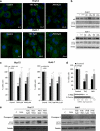
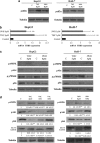
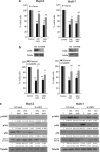

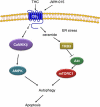
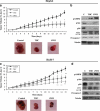

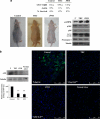
Similar articles
-
Cannabinoid action induces autophagy-mediated cell death through stimulation of ER stress in human glioma cells.J Clin Invest. 2009 May;119(5):1359-72. doi: 10.1172/jci37948. J Clin Invest. 2009. PMID: 19425170 Free PMC article.
-
The pseudokinase tribbles homologue-3 plays a crucial role in cannabinoid anticancer action.Biochim Biophys Acta. 2013 Oct;1831(10):1573-8. doi: 10.1016/j.bbalip.2013.03.014. Epub 2013 Apr 6. Biochim Biophys Acta. 2013. PMID: 23567453
-
Involvement of PPARγ in the antitumoral action of cannabinoids on hepatocellular carcinoma.Cell Death Dis. 2013 May 2;4(5):e618. doi: 10.1038/cddis.2013.141. Cell Death Dis. 2013. PMID: 23640460 Free PMC article.
-
From molecular biology to targeted therapies for hepatocellular carcinoma: the future is now.Oncology. 2007;72 Suppl 1:30-44. doi: 10.1159/000111705. Epub 2007 Dec 13. Oncology. 2007. PMID: 18087180 Review.
-
[De novo lipogenesis: role in hepatocellular carcinoma].Pathologe. 2011 Nov;32 Suppl 2:174-80. doi: 10.1007/s00292-011-1529-9. Pathologe. 2011. PMID: 21931995 Review. German.
Cited by
-
TNEA therapy promotes the autophagic degradation of NLRP3 inflammasome in a transgenic mouse model of Alzheimer's disease via TFEB/TFE3 activation.J Neuroinflammation. 2023 Feb 2;20(1):21. doi: 10.1186/s12974-023-02698-w. J Neuroinflammation. 2023. PMID: 36732771 Free PMC article.
-
The current state and future perspectives of cannabinoids in cancer biology.Cancer Med. 2018 Mar;7(3):765-775. doi: 10.1002/cam4.1312. Epub 2018 Feb 23. Cancer Med. 2018. PMID: 29473338 Free PMC article. Review.
-
In vitro and in vivo efficacy of non-psychoactive cannabidiol in neuroblastoma.Curr Oncol. 2016 Mar;23(2):S15-22. doi: 10.3747/co.23.2893. Epub 2016 Mar 16. Curr Oncol. 2016. PMID: 27022310 Free PMC article.
-
The Cannabinoid Receptor 2 Protects Against Alcoholic Liver Disease Via a Macrophage Autophagy-Dependent Pathway.Sci Rep. 2016 Jun 27;6:28806. doi: 10.1038/srep28806. Sci Rep. 2016. PMID: 27346657 Free PMC article.
-
Preclinical and Clinical Assessment of Cannabinoids as Anti-Cancer Agents.Front Pharmacol. 2016 Oct 7;7:361. doi: 10.3389/fphar.2016.00361. eCollection 2016. Front Pharmacol. 2016. PMID: 27774065 Free PMC article. Review.
References
-
- Shariff MI, Cox IJ, Gomaa AI, Khan SA, Gedroyc W, Taylor-Robinson SD. Hepatocellular carcinoma: current trends in worldwide epidemiology, risk factors, diagnosis and therapeutics. Expert Rev Gastroenterol Hepatol. 2009;3:353–367. - PubMed
-
- Whittaker S, Marais R, Zhu AX. The role of signaling pathways in the development and treatment of hepatocellular carcinoma. Oncogene. 2010;29:4989–5005. - PubMed
-
- Josephs DH, Ross PJ. Sorafenib in hepatocellular carcinoma. Br J Hosp Med (Lond) 2010;71:451–456. - PubMed
-
- Duffy A, Greten T. Developing better treatments in hepatocellular carcinoma. Expert Rev Gastroenterol Hepatol. 2010;4:551–560. - PubMed
Publication types
MeSH terms
Substances
LinkOut - more resources
Full Text Sources
Medical

